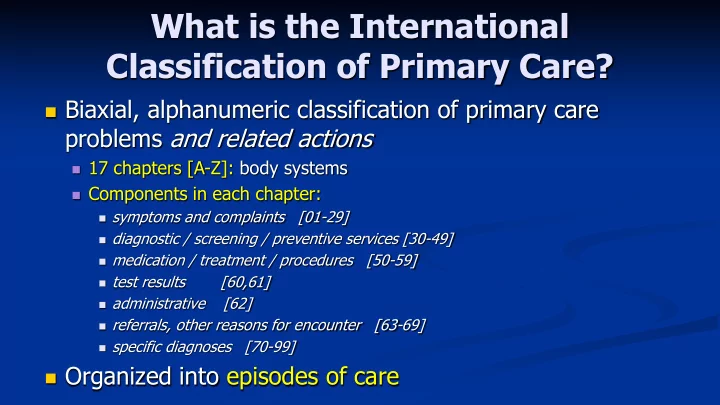

What is the International Classification of Primary Care? Biaxial, alphanumeric classification of primary care problems and related actions 17 chapters [A-Z]: body systems Components in each chapter: symptoms and complaints [01-29] diagnostic / screening / preventive services [30-49] medication / treatment / procedures [50-59] test results [60,61] administrative [62] referrals, other reasons for encounter [63-69] specific diagnoses [70-99] Organized into episodes of care
ICPC Produced by the WONCA International Classification Committee (WONCA = World Organization of Family Physicians) first published 1987 by Oxford University Press; second revision was published in 1998 2 nd revision was accepted within the World Health Organization Family of International Classifications 3rd Revision in Development
key features of ICPC Incorporates patient “voice” in Reason for encounter (RFE) Symptom diagnoses where appropriate Accommodates social problems (chapter Z) Episode-based - can track process of care for problem over time Limited granularity of basic code set – based upon prevalence of diagnosis NOT A TERMINOLOGY - mapped to standard terminologies, classifications
Maps and windows for ICPC ICPC-2-R to ICD-10 ICPC-2-R to ICD-9-CM ICPC-2 to SNOMED-CT primary care reference termset (refset) created by the IHTSDO GP/FP working group windows from ICPC to: CPT, SF-12, WONCA/COOP charts work on ATC-codes, ICF
Transhis
RFE shortness of breath in 25-44 yo N=973 episodes . ICPC Final Diagnosis Prevalence OR (post prob) R78 Acute bronchitis 27.8% 20.03 R02 Shortness of breath 12.7% R98 hyperventilation 11.7% 24.47 R96 Asthma 10.4% 57.09 R74 URI 8.6% 1.84 R75 Sinusitis 2.9% 0.82 R96 Pneumonia 2.8% 13.16 Source: EFP / Dutch Transition Project database
RFE shortness of breath in 65-74 yo N=788 episodes. ICPC Final Diagnosis Prevalence OR (post prob) R78 Acute bronchitis 30.4% 7.25 R02 Shortness of breath 14.6% K77 Heart failure 10.5% 15.13 R Emphysema/COPD 4.8% 21.14 R98 Hyperventilation 4.8% 12.92 R81 Pneumonia 4.3% 5.21 R96 Asthma 3.5% 4.0 Source: EFP / Dutch Transition Project database
Comorbid conditions in men 45-64 (n=613) and men 65-74 (n=547) with diabetes Diagnosis % 45-64 % 65-74 Hypertension 22.8% 28.8% Hyperlipidemia 13.2% 10.8% Ischemic heart disease 8.0% 14.1% Low back pain 8.0% 4.6% Sleep problems 5.2% 6.8% Depressive disorder 3.9% 4.6% ED/impotence 3.4% 1.8% Heart failure - 7.1% Source: EFP / Dutch Transition Project database
Primary Care Data Model Annals of Family Medicine, 2015 https://www.ncbi.nlm.nih.gov/pmc/articles/PMC4508165/
Recommend
More recommend